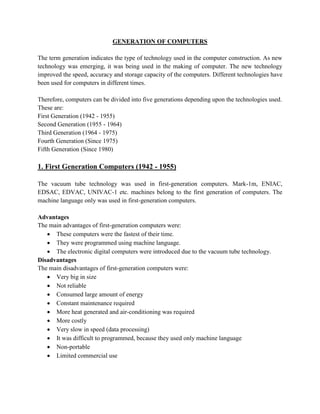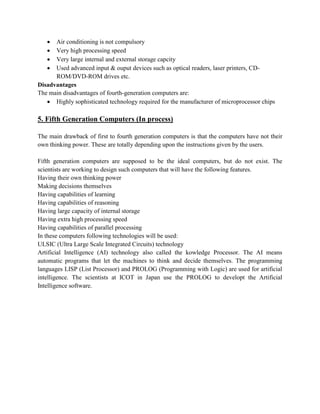Generation of computers
- 1. GENERATION OF COMPUTERS The term generation indicates the type of technology used in the computer construction. As new technology was emerging, it was being used in the making of computer. The new technology improved the speed, accuracy and storage capacity of the computers. Different technologies have been used for computers in different times. Therefore, computers can be divided into five generations depending upon the technologies used. These are: First Generation (1942 - 1955) Second Generation (1955 - 1964) Third Generation (1964 - 1975) Fourth Generation (Since 1975) Fifth Generation (Since 1980) 1. First Generation Computers (1942 - 1955) The vacuum tube technology was used in first-generation computers. Mark-1m, ENIAC, EDSAC, EDVAC, UNIVAC-1 etc. machines belong to the first generation of computers. The machine language only was used in first-generation computers. Advantages The main advantages of first-generation computers were: These computers were the fastest of their time. They were programmed using machine language. The electronic digital computers were introduced due to the vacuum tube technology. Disadvantages The main disadvantages of first-generation computers were: Very big in size Not reliable Consumed large amount of energy Constant maintenance required More heat generated and air-conditioning was required More costly Very slow in speed (data processing) It was difficult to programmed, because they used only machine language Non-portable Limited commercial use
- 2. 2. Second Generation Computers (1955 - 1964) The transistor technology was used in second-generation computers. The electronic component transistor was invented in 1948 at Bell Laboratories. The transistor is smaller in size and more reliable than vacuum tube. Therefore, the transistor technology was used in computer in place of vacuum tube technology. The programming assembly language was also introduced in second- generation of computers. Advantages The main advantages of second-generation computers as compared to first-generation computers are: Low in cost Smaller in size Fast in speed Less heat generated More reliable and accurate in calculations Consume low power etc. Used for commercial purposes Portable Assembly language was introduced. This language is easy to write program than machine language Disadvantages The main disadvantages of this generation computers were: Air-conditioning required Commercial production was difficult and these were very costly Constant (or frequent) maintenance required Only used for special purposes 3. Third Generation Computers (1964 - 1975) The IC (Integrated Circuits) technology was used in third-generation computers. In a small IC chip (5 mm square size) a circuit is designed having large number of electronic components like transistors, capacitors, diodes, resistors etc. Initially, an IC contained only about ten to twenty components. Thus the IC technology was named as Small Scale Integration (SSI). The third- generation was based on IC technology and the computers were designed using this technology. Advantages The main advantages of third-generation as compared to previous generations of computers were: Smaller in size
- 3. Production cost was low Very fast in computational power More reliable Low power consumption Maintenance cost was low because failure rate of harware was very low Magnetic disk, used for externale storage More storage capacity Easily portable Easy to operate Upgraded easily Widely used for various commercial applications all over the world Lower heat generated High-level languages were commonly used Many input/ouput devices were introduced such as mouse and keyboard etc. Disadvantages The main disadvantages of thir-generation computers were: Air-conditioning required Highly sophisticated technology required for the manufacturer chips 4. Fourth Generation Computers (1975 onwards) The microchip technology was introduced in this generation of computers. With the advancement in IC technology, LSI (Large Scale Integration) chips were developed. It was possible to itegrate over 30,000 or more components on to single LSI chip. After LSI, the VLSI (Very Large Scale Integration) was developed and the development of microprocessor possible. It is expected that more than one million components will be integrated on a single chip of VLSI. Using VLSI technology, the entire CPU is designed on a single silicon chip. The use of microprocessor as CPU introduced another class of computers called the microcomputers. Thus fourth-generation may be called Microcomputer generation. IBM introduced its personal computer for use in 1981. Advantages The advantages of fourth-generation as compared to previous generation computers are: Smaller in size Production cost is very low Very reliable Harware failure is negligible Easlity portable because of their small size Totally general purpose
- 4. Air conditioning is not compulsory Very high processing speed Very large internal and external storage capcity Used advanced input & ouput devices such as optical readers, laser printers, CD- ROM/DVD-ROM drives etc. Disadvantages The main disadvantages of fourth-generation computers are: Highly sophisticated technology required for the manufacturer of microprocessor chips 5. Fifth Generation Computers (In process) The main drawback of first to fourth generation computers is that the computers have not their own thinking power. These are totally depending upon the instructions given by the users. Fifth generation computers are supposed to be the ideal computers, but do not exist. The scientists are working to design such computers that will have the following features. Having their own thinking power Making decisions themselves Having capabilities of learning Having capabilities of reasoning Having large capacity of internal storage Having extra high processing speed Having capabilities of parallel processing In these computers following technologies will be used: ULSIC (Ultra Large Scale Integrated Circuits) technology Artificial Intelligence (AI) technology also called the kowledge Processor. The AI means automatic programs that let the machines to think and decide themselves. The programming languages LISP (List Processor) and PROLOG (Programming with Logic) are used for artificial intelligence. The scientists at ICOT in Japan use the PROLOG to developt the Artificial Intelligence software.




